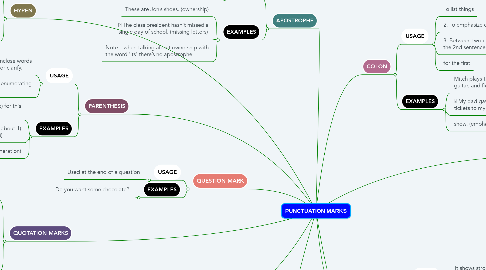
1. QUESTION MARK
1.1. USAGE
1.1.1. Used at the end of a question
1.2. EXAMPLES
1.2.1. Do you want some chocolate?
2. SEMICOLON
2.1. USAGE
2.1.1. It separates two complete sentences that are closely related in thought
2.2. EXAMPLES
2.2.1. I am vegetarian; I don’t eat meat.
3. APOSTROPHE
3.1. USAGE
3.1.1. 1. To show ownership 2. In place of missing letters (contractions)
3.2. EXAMPLES
3.2.1. These are Jon’s shoes. (ownership)
3.2.2. The class president hasn’t missed a single day of school. (missing letters)
3.2.3. Note – when talking about ownership with the word ‘its’ there’s no apostrophe.
4. QUOTATION MARKS
4.1. USAGE
4.1.1. 1. Quotation marks are used to show someone’s exact speech or words.
4.1.2. 2. They are also used for titles of books, movies, stories, etc.
4.1.3. 3. Sarcasm.
4.2. EXAMPLES
4.2.1. “Creativity is intelligence having fun,” said Albert Einstein. (exact words)
4.2.2. “Harry Potter and the Philosopher’s Stone” is a good fantasy novel for both
4.2.3. children and adults. (book title)
4.2.4. He married a “dancer”. (She’s actually a stripper.)
5. PARENTHESIS
5.1. USAGE
5.1.1. 1. Parenthesis are used to enclose words that either add more detail or clarify.
5.1.2. 2. They are also used for enumerating within a sentence.
5.2. EXAMPLES
5.2.1. I paid 40,000 Won (around $35) for this skirt. (more detail)
5.2.2. The guest speaker talked about 1) productivity, 2) focus, and 3)
5.2.3. momentum. (enumeration)
6. SLASH
6.1. USAGE
6.1.1. 1. A slash is used to show alternatives and is used in set phrases like and/or,
6.1.2. if/when, and man/woman.
6.1.3. 2. It can also be used to show opposite ideas or relationships.
6.2. EXAMPLES
6.2.1. If a person dies without a will, what happens to his/her
6.2.2. property? (alternatives)
6.2.3. I have a love/hate relationship with food. (opposite concepts)
7. HYPEN
7.1. USAGE
7.1.1. 1. A hyphen joins two or more words to make compound words.
7.1.2. 2. We often use hyphens for numbers like Social Security numbers or phone
7.2. EXAMPLES
7.2.1. The company needs a long-term solution. (compound word)
7.2.2. The phone number to the emergency center is 1-800-273-TALK. (string of
8. FULL POINT
8.1. USAGE
8.1.1. 1. As a full stop, it is used at the end of a declarative or imperative sentence.
8.1.2. 2. As a full point, it is used at the end of abbreviations.
8.1.2.1. 3. As a full point, it is also used at the end of initials.
8.2. EXAMPLES
8.2.1. The food is delicious. (declarative)
8.2.2. Open a window. (imperative)
8.2.3. Dr. Goldberg is a well-known doctor. (abbreviation)
8.2.4. A. A. Milne wrote Winnie-the-Pooh. (initials)
9. EXCLAMATION MARK
9.1. USAGE
9.1.1. It shows strong emotion and is used at the end of an exclamatory sentence.
9.2. EXAMPLES
9.2.1. I got a promotion!
10. COMMA
10.1. USAGE
10.1.1. 1. In a list of 3 or more things
10.1.2. 2. When a number is over 999
10.1.3. 3. With dates
10.1.4. 4. With addresses
10.1.5. 5. With quotations
10.1.6. 6. Between adjectives
10.1.7. 7. Between adverbs
10.1.8. 8. After introductory words and clauses
10.1.9. 9. To join independent clauses
10.1.10. 10.During pauses in breath, or for nonrestrictive elements
10.2. EXAMPLES
10.2.1. My pets are a cat, a dog, and a goldfish. (list)
10.2.2. The genie in Aladdin’s lamp spent 10,000 years in captivity. (number)
10.2.3. Martin Luther King delivered his memorable ‘I have a Dream’ speech
10.2.4. on August 28, 1963. (date)
10.2.5. We visited Anne Frank’s house in Amsterdam, The Netherlands. (address)
10.2.6. “We are all fools in love,” said Charlotte to Elizabeth. (quotation – note it
10.2.7. goes before the quote marks here)
10.2.8. The food in the restaurant was delicious, filling, and cheap. (adjectives –
10.2.9. putting the comma before the third item is called an Oxford Comma and
10.2.10. that’s how I use commas)
10.2.11. The repaired car ran smoothly, quietly, and quickly. (adverbs)
11. COLON
11.1. USAGE
11.1.1. To list things
11.1.2. 2. To emphasize one thing
11.1.3. 3. Between two complete sentences where the 2nd sentence is an explanation
11.1.4. for the first
11.2. EXAMPLES
11.2.1. Mitch plays three instruments: piano, guitar, and flute. (list)
11.2.2. My dad gave me the best gift ever: tickets to my favorite Broadway
11.2.3. show. (emphasis)

